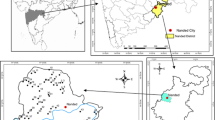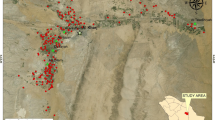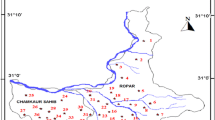Abstract
The present study deals with detailed hydrochemical assessment of groundwater within the Saq aquifer. The Saq aquifer which extends through the NW part of Saudi Arabia is one of the major sources of groundwater supply. Groundwater samples were collected from about 295 groundwater wells and analyzed for various physico-chemical parameters such as electrical conductivity (EC), pH, temperature, total dissolved solids (TDS), Na+, K+, Ca2+, Mg2+, CO3 −, HCO3 −, Cl−, SO4 2−, and NO3 −. Groundwater in the area is slightly alkaline and hard in nature. Electrical conductivity (EC) varies between 284 and 9,902 μS/cm with an average value of 1,599.4 μS/cm. The groundwater is highly mineralized with approximately 30 % of the samples having major ion concentrations above the WHO permissible limits. The NO3 − concentration varies between 0.4 and 318.2 mg/l. The depth distribution of NO3 − concentration shows higher concentration at shallow depths with a gradual decrease at deeper depths. As far as drinking water quality criteria are concerned, study shows that about 33 % of samples are unfit for use. A detailed assessment of groundwater quality in relation to agriculture use reveals that 21 % samples are unsuitable for irrigation. Using Piper’s classification, groundwater was classified into five different groups. Majority of the samples show Mix-Cl-SO4- and Na-Cl-types water. The abundances of Ca2+ and Mg2+ over alkalis infer mixed type of groundwater facies and reverse exchange reactions. The groundwater has acquired unique chemical characteristics through prolonged rock-water interactions, percolation of irrigation return water, and reactions at vadose zone.







Similar content being viewed by others
References
Al-Amry, A. S. (2008). Hydrogeochemistry and groundwater quality assessment in an arid region: a case study from Al Salameh Area, Shabwah, Yemen, The 3rd International Conference on Water Resources and Arid Environments, The 1st Arab Water Forum.
Al-Bassam, A. M., Hussein, T., & Sharaf, M. A. (1997). Hydrochemical evaluation of the Umm-er-Radhuma Aquifer system, Saudi Arabia, Hydrochemistry (Proceedings of the Rabat Symposium, April 1997) IAHS Publ.no. 244.
American public Health association (APHA). (1995). Standard methods for the examination of water and wastewater (19th ed.). Washington DC, USASS: APHA.
BUREAU DE RECHERCHES GÉOLOGIQUES ET MINIÈRES (BRGM). (1985). Water, agriculture, and soil studies of Saq and overlying aquifers, unpublished report on file. Kingdom of Saudi Arabia: Ministry of Agriculture.
Datta, P. S., Bhattacharya, S. K., & Tyagi, S. K. (1996). 18O studies on recharge of phreatic aquifers and groundwater flow paths of mixing in Delhi area. J Hydrol, 176, 25–36.
Eaton, F. M. (1950). Significant of carbonate in irrigation waters. Soil Sci, 59, 123–133.
FAO (2009). Food and Agriculture Organization of the United Nation, Draft Synthesis Report, Groundwater Management in Saudi Arabia, p.14. Available online at: http://www.groundwatergovernance.org/fileadmin/user_upload/groundwatergovernance/docs/Country_studies/Saudi_Arabia_Synthesis_Report_Final_Morocco_Synthesis_Report_Final_Groundwater_Management.pdf.Accessed 18 May 2013.
Freeze, R. A., & Cherry, J. A. (1979). Groundwater: prentice hall. New Jersey: Englewood Cliffs.
Garcia, M. G., Del Hidalgo, M., & Blesa, M. A. (2001). Geochemistry of groundwater in the alluvial plain of Tucuman province, Argentina. Journal of Hydrology, 9, 597–610.
Gibbs, R. J. (1970). Mechanisms controlling world’s water chemistry. Science, 170, 1088–1090.
Gold, A. J., DeRagon, R. W., Sullivan, M. W., & Lemunyon, J. L. (1990). Nitrate-nitrogen losses to groundwater from rural and suburban land uses. J Soil Water Conserv, 45, 305–310.
Kelley, W. P., Brown, S. M., & Leibig, G. I., Jr. (1940). Chemical effects of saline irrigation water on soils. Soil Sciences, 49, 95–107.
Marghade, D., Malpe, D. B., & Zade, A. B. (2012). Major ion chemistry of shallow groundwater of a fast growing city of Central India. Environ Monit Assess, 184, 2405–2418.
Ministry of Water and Electricity, & Kingdom of Saudi Arabia. (2008). Investigations for updating the groundwater mathematical models of the Saq and overlying aquifers. Kingdom of Saudi Arabia: Unpublished report on file, Ministry of Water and Electricity.
Parsons-Basil Consultants (1969). Agriculture and water resources, the Great Nafud Sedimentary Basin, Final Report. Saudi Arabia: Ministry of Agriculture and Water.
Piper, A. M. (1944). A graphical procedure in the geochemical interpretation of water analyses, transactions. American Geophysical Union, 25, 914–928.
Rao, N. S., Rao, J. P., Devadas, D. J., Rao, K. V., Krishna, C., & Rao, B. N. (2002). Hydrochemistry and groundwater quality in developing urban environment of a semi-arid region. Andhra: Guntur.
Ravikumar, P., Venkatesharaju, K., Prakash, K. L., & Somashekar, R. K. (2011). Geochemistry of groundwater and groundwater prospects evaluation, Anekal Taluk, Bangalore Urban District, Karnataka, India. Environmental Monitoring and Assessment, 179, 93–112.
Richards, L. A (1954). Diagnosis and improvement of saline alkaline soils, US Department of Agriculture, Handbook 60 (160).
Sarin, M. M., Krishnaswamy, S., Dilli, K., SomayaJulu, B. L. K., & Moore, W. S. (1989). Major ion chemistry of the Ganga-Brahmputra river system: weathering processes and fluxes in the Bay of Bengal. Geochimica et Cosmochimica Acta, 53, 997–1009.
Sawyer, C. N., & McCarty, P. L. (1967). Chemistry for sanitary, IV Edtn. New York: McGraw Hill.
Schoeller, H. (1965). Hydrodynamique lans le karst. Actes du Colloque de Dubrovnik, IAHS/ UNESCO, 3–20 pp.
Soltan, M. E. (1998). Characterization, classification and evaluation of some groundwater samples in upper Egypt. J Chemosphere, 37, 735–745.
Srinivasamoorthy, K., Chidambaram, S., Prasanna, M. V., Vasanthavihar, M., Peter, J., Anandhan P. (2008). Identification of major sources controlling groundwater chemistry from a hard rock terrain –a case study from Mettur taluk, Salem district, Tamil Nadu, India, Journal of Earth System Science 117, No. 1, February 2008, pp. 49–58.
Subba Rao, N. (2002). Geochemistry of groundwater in part of Guntur Dist., A.P., India. Environ Geol, 41, 552–562.
Subba Rao, N., Surya Rao, P., Venktram Reddy, G., Nagamani, M., Vidyasagar, G., & Satyanarayana, N. L. V. V. (2012). Chemical characteristics of groundwater and assessment of groundwater quality in Varaha River Basin, Visakhapatnam District, Andhra Pradesh, India. Environ Monit Assess, 184, 5189–5214.
Thorne, D. W., & Peterson, H. B. (1954). Irrigated soils. London: Constable and Company.
Todd, D. (1980). Ground water hydrology. New York: Wiley.
Trojan, M. D., Maloney, J. S., Stockinger, J. M., Eid, E. P., Lahtinen, M. J. (2003). Effect of land use on groundwater quality in the Anoka Sand Plain aquifer of Minnesota. Ground Water, 41(4), 482–492.
Umar, R., & Ahmed, I. (2007). Hydrochemical characteristics of groundwater in parts of Krishni-Yamuna Basin, Muzaffarnagar district, U.P. Jour Geol Soc India (Springer), 69, 989–995.
Umar, R., Ahmed, I., Alam, F., & Khan, M. M. A. (2009). Hydrochemical characteristics and seasonal variations in groundwater quality of an alluvial aquifer in parts of Central Ganga Plain, Western Uttar Pradesh, India. Environmental Earth Sciences (Springer), 58, 1295–1300.
Water Atlas (1984). Water Atlas of Saudi Arabia, Ministry of Agriculture and Water in cooperation with the Saudi Arabian-United sates joint commission on economic cooperation, Page-119.
White, P., Ruble, C. L., & Lane, M. E. (2013). The effect of changes in landuse on nitrate concentration in water supply wells in southern Chester county, Pennsylvania. Environ Monit Assess, 185, 643–651.
Wilcox, L. V. (1955). Classification and use of irrigation waters, USDA, circular 969. DC, USA: Washington.
Acknowledgments
This work is financially supported by the National Plan for Science, Technology and Innovation (NPST) program, King Saud University, Saudi Arabia (Project No. 12-WAT 2453–02).
Author information
Authors and Affiliations
Corresponding author
Rights and permissions
About this article
Cite this article
Nazzal, Y., Ahmed, I., Al-Arifi, N.S.N. et al. A pragmatic approach to study the groundwater quality suitability for domestic and agricultural usage, Saq aquifer, northwest of Saudi Arabia. Environ Monit Assess 186, 4655–4667 (2014). https://doi.org/10.1007/s10661-014-3728-3
Received:
Accepted:
Published:
Issue Date:
DOI: https://doi.org/10.1007/s10661-014-3728-3




